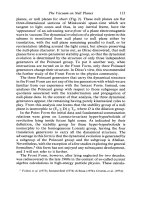Chapter 001. The Practice of Medicine (Part 6) ppsx
Bạn đang xem bản rút gọn của tài liệu. Xem và tải ngay bản đầy đủ của tài liệu tại đây (14.84 KB, 5 trang )
Chapter 001. The Practice of Medicine
(Part 6)
The Dichotomy of Inpatient and Outpatient Internal Medicine
The hospital environment has transformed dramatically over the past few
decades. In more recent times, emergency departments and critical care units have
evolved to identify and manage critically ill patients, allowing them to survive
formerly fatal diseases. There is increasing pressure to reduce the length of stay in
the hospital and to manage complex disorders in the outpatient setting. This
transition has been driven not only by efforts to reduce costs but also by the
availability of new outpatient technologies, such as imaging and percutaneous
infusion catheters for long-term antibiotics or nutrition, and by evidence that
outcomes are often improved by minimizing inpatient hospitalization. Hospitals
now consist of multiple distinct levels of care, such as the emergency department,
procedure rooms, overnight observation units, critical care units, and palliative
care units, in addition to traditional medical beds. A consequence of this
differentiation has been the emergence of new specialties such as emergency
medicine, intensivists, hospitalists, and end-of-life care. Moreover, these systems
frequently involve "hand-offs" from the outpatient to the inpatient environment,
from the critical care unit to a general medicine floor, and from the hospital to the
outpatient environment. Clearly, one of the important challenges in internal
medicine is to maintain continuity of care and information flow during these
transitions, which threaten the traditional one-to-one relationship between patient
and physician. In the current environment, teams of physicians, specialists, and
other health care professionals have often replaced the personal interaction
between doctor and patient. The patient can benefit greatly from effective
collaboration among a number of health care professionals; however, it is the duty
of the patient's principal or primary physician to provide cohesive guidance
through an illness. In order to meet this challenge, the primary physician must be
familiar with the techniques, skills, and objectives of specialist physicians and
allied health professionals. The primary physician must ensure that the patient will
benefit from scientific advances and from the expertise of specialists when they
are needed, while still retaining responsibility for the major decisions concerning
diagnosis and treatment.
Appreciation of the Patient's Hospital Experience
The hospital is an intimidating environment for most individuals.
Hospitalized patients find themselves surrounded by air jets, buttons, and glaring
lights; invaded by tubes and wires; and beset by the numerous members of the
health care team—nurses, nurses' aides, physicians' assistants, social workers,
technologists, physical therapists, medical students, house officers, attending and
consulting physicians, and many others. They may be transported to special
laboratories and imaging facilities replete with blinking lights, strange sounds, and
unfamiliar personnel; they may be left unattended for periods of time; they may be
obliged to share a room with other patients who have their own health problems. It
is little wonder that patients may lose their sense of reality. Physicians who can
appreciate the hospital experience from the patient's perspective and make an
effort to develop a strong personal relationship with the patient whereby they may
guide the patient through this experience can make a stressful situation more
tolerable.
Trends in the Delivery of Health Care: A Challenge to the Humane
Physician
Many trends in the delivery of health care tend to make medical care
impersonal. These trends, some of which have been mentioned already, include (1)
vigorous efforts to reduce the escalating costs of health care; (2) the growing
number of managed-care programs, which are intended to reduce costs but in
which the patient may have little choice in selecting a physician or in seeing that
physician consistently; (3) increasing reliance on technological advances and
computerization for many aspects of diagnosis and treatment; (4) the need for
numerous physicians to be involved in the care of most patients who are seriously
ill; and (5) an increased number of malpractice suits, some of which are justifiable
because of medical errors, but others of which reflect an unrealistic expectation on
the part of many patients that their disease will be cured or that complications will
not occur during the course of complex illnesses or procedures.
Given these changes in the medical care system, it is a major challenge for
physicians to maintain the humane aspects of medical care. The American Board
of Internal Medicine, working together with the American College of Physicians–
American Society of Internal Medicine and the European Federation of Internal
Medicine, has published a Charter on Medical Professionalism that underscores
three main principles in physicians' contract with society: (1) the primacy of
patient welfare, (2) patient autonomy, and (3) social justice. Medical schools have
also increased their emphasis on physician professionalism in recent years (Fig. 1-
1). The humanistic qualities of a physician must encompass integrity, respect, and
compassion. Availability, the expression of sincere concern, the willingness to
take the time to explain all aspects of the illness, and a nonjudgmental attitude
when dealing with patients whose cultures, lifestyles, attitudes, and values differ
from those of the physician are just a few of the characteristics of the humane
physician. Every physician will, at times, be challenged by patients who evoke
strongly negative or positive emotional responses. Physicians should be alert to
their own reactions to such patients and situations and should consciously monitor
and control their behavior so that the patient's best interest remains the principal
motivation for their actions at all times.
An important aspect of patient care involves an appreciation of the patient's
"quality of life," a subjective assessment of what each patient values most. Such an
assessment requires detailed, sometimes intimate knowledge of the patient, which
can usually be obtained only through deliberate, unhurried, and often repeated
conversations. Time pressures will always threaten these interactions, but they
should not diminish the importance of understanding and seeking to fulfill the
priorities of the patient.









